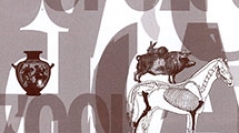

 Anthropozoologica
48 (2) - Pages 371-380
Anthropozoologica
48 (2) - Pages 371-380The knuckle-bone has always had both a ritual function linked to the practice of divination and a profane use as a gaming piece for infants and adults. Knuckle bones from different animal species can be used, but sheep and goat (Ovis and Capra) and pig (Sus domesticus) generally prevail. These bones are small and can easily be handled together. Groups of worked and non-modified knucklebones have been discovered in several archaeological contexts in Italy. The most important evidence for the funerary use of these bones in Italy is undoubtedly presented by the thousands of knuckle-bones discovered in the cemetery of Locri Epizefiri, dated to the Hellenistic period. In recent times, large amounts of worked and non-modified knuckle-bones have been brought to light in the cemeteries of Le Grotte near Populonia (4th-3rd c. BC) and Poggio Picenze in Abruzzi (3rd-2nd c. BC). The zooarchaeological analysis of these samples and their comparison with other evidence can contribute to our understanding of several aspects of the ancient use of the knuckle-bone, such as the choice of the animal, different kinds of modifications, the modalities and significance of types of depositional features.
Knuckle bones, funerary custom, Iron Age, Roman Period, Italy.